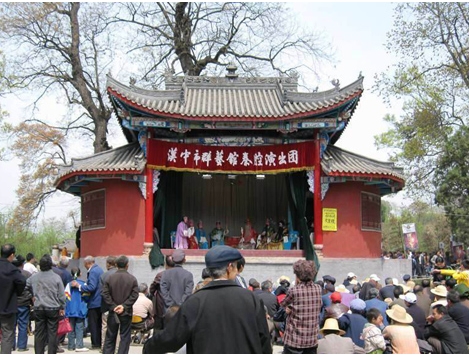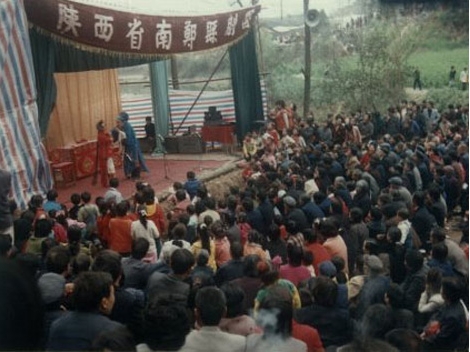 '
'
The Han Tune Guangguang Opera, also called Guangguangzi opera, is popular in Hanzhong and Ankang in southern Shaanxi Province. It is thus named because the singing and narration of the opera are based on the Hanzhong dialect (dialect in the Hanshui River Valley), and the sound of "guangguang" produced by bangzi (slit drum). As principal meter names, rhythmic structure and major accompanying instruments of the Guangguang opera share much similarity with Shaanxi opera (Qinqiang), it is also called Nanlu Qinqiang (literally southern Shaanxi opera) and Han Tune Qinqiang. There is a proverb, saying "Eat Bangbangzi noodles if you want to have noodles; watch Guangguangzi Opera if you want to enjoy opera".
The Han Tune Guangguang Opera used to be dominant in the Guanzhong area for a long time. In the late Qing Dynasty and the early years of the Republic of China in particular, the opera experienced a golden age, giving rise to a large number of troupes and excellent artists. A lot of outstanding opera writers also appeared in this period. Their works greatly promoted social advancement at that time. The Han Tune Guangguang Opera has a large repertoire. There are more than 700 traditional plays, over 560 complete series, and 170-odd highlights, among which Liu Gao Grinding the Knife, Wrought Iron Sword, Mountain at the Sunset, Water Flooding Jinyang City, and Red Tassel Cloak are exclusively owned by the opera. Some plays like Imperial Pearl, Shadowless Sword, Twittering Pavilion and Reasoning at the Grass Slope have been lost or become incomplete in other genres of opera.

The Han Tune Guangguang Opera follows the banqiang style. It is as loud and sonorous as Shaanxi Opera, and on the other hand, owns graceful and gentle features of local music in southern Shaanxi. Female characters sing exaltedly, and use the tune of yingsanyan; painted-face characters are good at jiang voice, and often sing with falsetto and a long drawl at the last word, known as the "laoshao pei" (literally elder-youth cooperation). The Han Tune Guangguang Opera includes varied meters, such as erliu, manban, jianban and lantou, which can be categorized into "soft", "hard", "fast" and "slow", based on various emotions. As to the accompanying instruments, there are stringed and wind instruments, such as gaiban erxian which was changed to banhu later, jinghu, haidi and sanxian, and percussion instruments, such as pointed drum, flat drum, hooked gong, cymbals, bangzi (slit drum), yazi and wooden fish.
The performance of the Han Tune Guangguang Opera pursues considerable exaggeration. It includes many unique skills, such as "truss the bucket", "sprinkle lotus flowers", "play with chairs", "stick rackets", "diaomaogai", "change face", "change costumes", "carry the fire", and a lot of special postures with swords and spears, sticks, kicking and beating, and somersaults. Before the founding of the Republic of China, male and painted-face characters wore straw sandals instead of boots in performances, so troupes of Han Tune Guangguang Opera were called "troupes of straw sandals". The opera does not stress makeup either. Female characters, for example, just wear powder and flowers during performances. However, the Han Tune Guangguang Opera values singing very much.